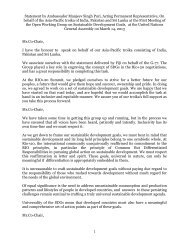STATE OF THE WORLD'S CITIES 2012/2013 Prosperity
STATE OF THE WORLD'S CITIES 2012/2013 Prosperity
STATE OF THE WORLD'S CITIES 2012/2013 Prosperity
You also want an ePaper? Increase the reach of your titles
YUMPU automatically turns print PDFs into web optimized ePapers that Google loves.
The manufacture of bicycles is dominated by China,<br />
India and the European Union, all of which account for<br />
87 per cent of global production. However, China alone<br />
produces more than half the world’s bicycles.<br />
DRIvERS AND CAPACITy-BUILDING FOR<br />
ENvIRONMENTAL SUSTAINABILITy<br />
Sustainable urban policies are driven by seven main<br />
factors: availability of financial resources, human resources,<br />
appropriate technology, specialised institutions, access to<br />
information, adequate organisational arrangements, and<br />
supportive legal frameworks.<br />
Approximately one-third of local experts across all<br />
regions are of the view that mechanisms for coordination<br />
between city and national authorities regarding<br />
environmental sustainability are already in place<br />
(Table 2.5.1). Less than one-third report that cities are<br />
mobilising investment to support sustainable resource use,<br />
or pulling their resources together in order to enhance<br />
environmental sustainability.<br />
These efforts can only go so far, it would seem, as<br />
experts simultaneously highlight the widespread problem of<br />
inadequate capacity. This refers to lack of not just finance,<br />
but also effective arrangements to facilitate partnerships<br />
with stakeholders, together with weak institutional<br />
frameworks and poor urban governance structures. 44 These<br />
conditions have drastically restraining effects on cities’<br />
ability for effective mitigation and adaptation.<br />
Similarly, cities and local authorities in developing<br />
countries may find it difficult to prioritize environmental<br />
Table 2.5.1<br />
Drivers of Environmental Sustainability in Cities*<br />
Regions<br />
Available mechanism(s) for<br />
coordination between local and<br />
national authorities concerning<br />
sustainability (%)<br />
85<br />
Environmental Sustainability and the <strong>Prosperity</strong> of Cities<br />
POLICy<br />
Public transport jobs account for 1–2 per cent of<br />
total employment in many countries. In Europe<br />
and the USA, some 30 jobs are created for every USD 1.4<br />
million invested in public transport infrastructure, and another<br />
57 in transport operations proper. 42<br />
POLICy<br />
Pilot projects in the Philippines suggest that<br />
retrofits of two-stroke engines on two- and<br />
three-wheeled vehicles − the most popular public transport<br />
in many developing countries − has cut fuel consumption<br />
by 35–50 per cent and emissions of air pollutants by as<br />
much as 90 per cent. Installing and servicing the kits creates<br />
employment. 43<br />
sustainability issues and challenges over and above<br />
unemployment, poverty, housing shortages, infrastructures<br />
and services, especially where local political expediency<br />
demands this type of action.<br />
This underscores the importance of growth and<br />
prosperity to the capacity of cities to address urban<br />
environmental sustainability issues, and this is also why<br />
they must be innovative and inventive when dealing with<br />
historic urban environmental problems while shaping an<br />
environmentally sustainable future. This situation highlights<br />
the fact that the twin dynamics of sustainability and economic<br />
prosperity are inevitably subject to a number of structural<br />
constraints that are specific to each and every urban area<br />
regardless of size.<br />
Leveraging of investments to<br />
support sustainable resource<br />
use and lower greenhouse<br />
gas emissions (%)<br />
Africa 31 20 20<br />
Arab States 37 35 35<br />
Asia 48 49 48<br />
Latin America & Caribbean 26 18 20<br />
All Regions 34 29 29<br />
* As perceived by local experts surveyed by UN-Habitat<br />
Source: UN-Habitat, City Monitoring Branch, Policy Survey, 2011<br />
Municipalities in same city/<br />
region combining resources<br />
& partnering together for<br />
enhanced environmental<br />
sustainability (%)


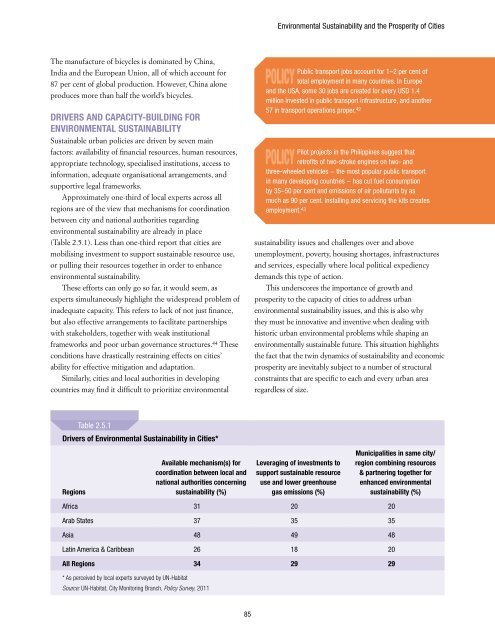

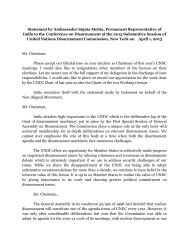



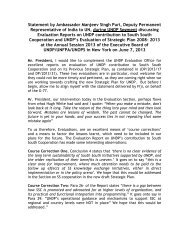




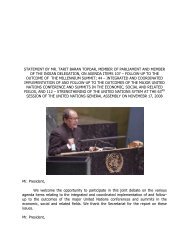

![1 statement by dr.[mrs] kakoli ghosh dastidar - Member States Portal](https://img.yumpu.com/27526598/1/190x245/1-statement-by-drmrs-kakoli-ghosh-dastidar-member-states-portal.jpg?quality=85)
